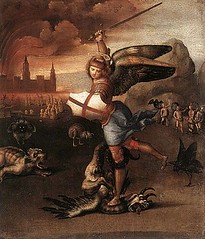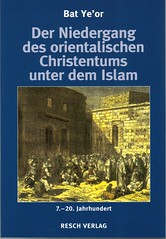 The finding of the sacred remains of St. James, the Son of Thunder, by Bishop Teodomirus signalled the general call to war against the Moorish (Islamic) invaders, who had by then the control of the greatest part of the Peninsula, the Northwest excepted, and had even entered into France, menacing the rest of Christendom. A small militia under King Don Pelayo had already repelled the invaders at the battle of Covadonga, in 718, starting the Reconquista of Spain.
The finding of the sacred remains of St. James, the Son of Thunder, by Bishop Teodomirus signalled the general call to war against the Moorish (Islamic) invaders, who had by then the control of the greatest part of the Peninsula, the Northwest excepted, and had even entered into France, menacing the rest of Christendom. A small militia under King Don Pelayo had already repelled the invaders at the battle of Covadonga, in 718, starting the Reconquista of Spain.
It was at Clavijo, in 845, that the forces of King Ramiro I defeated the far superior army of Abderraman II. The galvanizing cry of the Christian soldiers was ¡Santiago y cierra España!, "For St. James, and close ranks, Spain!" The General Chronicle of King Alfonso X the Wise reports a miraculous event during the battle of Clavijo, which gave the cult of St. James a dramatic configuration. According to witnesses, Santiago was seen descending from the sky mounted on a white horse, having in one hand a snow-white banner on which was displayed a blood red cross, and in the other a sword, en un cavallo blanco con una senya blanca et grand espada reluzient en la mano. We may interpret this intervention of St. James as a precise fact or as a poetic licence; what matters is the undeniable fact of the miraculous protection of the Son of Thunder, who will become from this time on the Patron of Spain. The imagery will present him thereafter as a knight on a white horse, carrying a banner with the Cross of Santiago and wielding a flashing sword. Protector of Christendom, he became Santiago Matamoros, the Moor slayer. And the Mozarabic Office salutes him from then on as Defensor Almae Hispaniae, Jacobe, vindex hostium, "James, defender of the soul of Spain, punisher of its enemies."
If Islam was able to subjugate the Visigothic monarchy with the help of the Prophet Mohammed, the small Christian troops will counterattack with the assistance of St. James. As Américo Castro put it, Cruzadas versus Alcoranadas, or the Cross against the Koran.
The vocation of the Son of Thunder for combat against the infidels manifested itself in countless occasions during the Reconquista and every war in defence of Holy Religion, up to our days. Caudillo de Cruzados, "commander of crusaders," he was invoked by the soldiers fighting the Reds during the Spanish civil war (1936-1939) and especially during the decisive battle of the river Ebro. Generalissimo Francisco Franco went as far as stating: "If one wants to get rid of Spain, take away Santiago."
Santiago Matamoros, in the words of Félix Sardá y Salvany, the great Catalan anti-Liberal apologist, "is the most perfect and adequate representation of the faith of our people; the faith of Spain is indeed a militant faith; this is what has characterized us always an even nowadays; this is what makes incomprehensible to foreigners the major part of our history’s pages, as well as the attitudes and events of today’s Spain. One must understand that we are and want to remain heirs and disciples of an armed apostle and of a Santiago fighting bloody battles on horseback: this is the key to decipher the enigma of our apparently strange national character."
Indeed, the Catholic history of Spain is founded upon the blood of countless martyrs, from the early disciples of Santiago until those who in the tragic and glorious epopee of 1936-1939 died with a smile, forgiving their assassins and crying ¡Viva Cristo Rey!
The restoration of Christendom requires, today as ever, a militant approach to every facet of life, and Santiago is perhaps our best model. Una manu sua faciebat opus et altera tenebat gladium. Work and combat, under Mary’s protection; we should make ours these two lessons of Santiago: constant work and militant attitude in order to defend the principles of Catholic civilization.
See: Rorate Caeli - Blog
See also:



